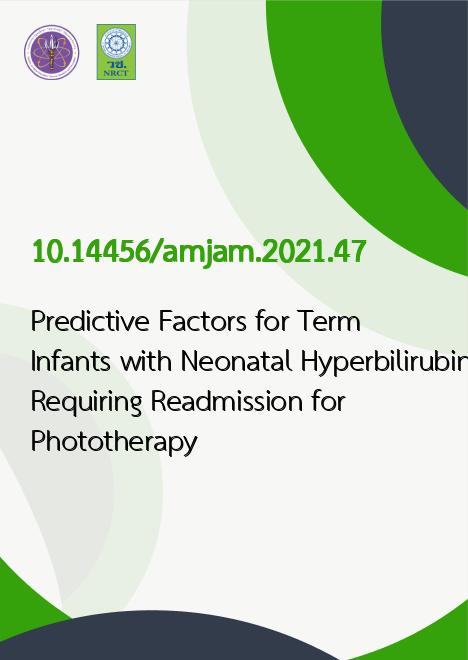
|
Predictive Factors for Term Infants with Neonatal Hyperbilirubinemia Requiring Readmission for Phototherapy |
|---|---|
| รหัสดีโอไอ | |
| Creator | Sariya Prachukthum |
| Title | Predictive Factors for Term Infants with Neonatal Hyperbilirubinemia Requiring Readmission for Phototherapy |
| Contributor | Chamnan Tanprasertkul, Sukkrawan Intarakhao |
| Publisher | Thammasat Printing House |
| Publication Year | 2564 |
| Journal Title | Asian Medical Journal and Alternative Medicine |
| Journal Vol. | 21 |
| Journal No. | 1 |
| Page no. | 14 |
| Keyword | Jaundice, Neonatal hyperbilirubinemia, Predict, Readmission, Term infant |
| URL Website | http://asianmedjam.com/ |
| Website title | asianmedjam |
| ISSN | 2730-3578 |
| Abstract | Background: Neonatal jaundice is one of the most common problems which often develops after term infants are discharged at the age of 48 hours. Identifying risk factors may prevent severe hyperbilirubinemia which can cause an irreversible neuronal damage.Objectives: To predict which term infants would need phototherapy after 48 hours of age.Methods: A prospective cohort study of 2,841 healthy newborns with gestational age of 37 weeks or more, born at Thammasat University Hospital between June 1st, 2017 and April 19th, 2018 was conducted. Risk factors and serum bilirubin level at 48 hours of life were obtained from individual chart review. We used multivariate logistic regression to identify risk factors, and receiver operator characteristic curve (ROC curve) to compare predictive accuracy.Results: There were 115 (3.8%) term infants with neonatal hyperbilirubinemia requiring readmission for phototherapy after 48 hours of age. Significant risk factors were predischarge bilirubin in high intermediate risk zone (adjusted odds ratio [aOR] 80.36, 95% confidence interval [CI] 37.47 - 172.36, P < 0.01), predischarge bilirubin in low intermediate risk zone (aOR 9.71, 95% CI 4.91 - 19.21, P < 0.01), gestational infants at 37-38 weeks (aOR 4.26, 95% CI 2.7 - 6.71, P < 0.01), cesarean section (aOR 2.44, 95% CI 1.6 - 3.73, P < 0.01), and weight loss more than 5% two days after birth (aOR 1.76, 95% CI 1.09 - 2.86, P = 0.02). The predictive performance of these risk factors in combination (AUC = 0.859, 95% CI = 0.82 - 0.89) was significantly different from the predictive accuracy of the predischarge bilirubin risk zone (AUC = 0.793, 95% CI = 0.76 - 0.83).Conclusions: Predicting neonatal hyperbilirubinemia requiring readmission for phototherapy is important. The predischarge bilirubin risk level, combined with the clinical risk factors (gestational age, delivery mode, and bodyweight percentage lost at 2 days of age), was more prediction accuracy than using predischarge bilirubin risk level or either clinical risk factors. |